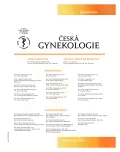The finding of isolated oligohydramnios after 37th week of gestation and its association with perinatal outcome
Authors:
J. Hederlingová 1; M. Redecha 2; J. Záhumenský 1
Authors‘ workplace:
II. gynekologicko-pôrodnícka klinika LF UK a UNB, Nemocnica Ružinov, Bratislava
prednosta doc. MUDr. J. Záhumenský, Ph. D.
1; I. gynekologicko-pôrodnícká klinika LF UK a UNB, Nemocnica sv. Cyrila a Metoda, Bratislava
prednosta prof. MUDr. M. Borovský, CSc.
2
Published in:
Ceska Gynekol 2017; 82(5): 351-354
Overview
Objective:
The objective of this study is to determinate the influence of oligohydramnios on perinatal outcome in term pregnancies.
Design:
Retrospective case-control study.
Setting:
II. Gynecologic Obstetrics Department, Comenius University, Bratislava.
Methods:
Authors analysed a group of 372 single pregnancies after completed 37th week of gestation in years 2011 to 2015 with sonographic diagnosis of isolated oligohydramnios. A control group was created with matched patients by age and parity with normal amniotic fluid volume.
Results:
We found significant differences in number of obstetric intervention between the two groups: patients with oligohydramnios had higher number of cesarean sections (71% compared to 33.9% in control group) and also the number of inductions was significantely higher (27.4% compared to 18.8%). The most common indication for cesarean delivery was presumed fetal hypoxia. We did not find any differences in numbers of neonates with low Apgar score, low umbilical cord pH and admission to neonatal intensive care unit.
Conclusion:
The finding of isolated oligohydramnios after 37th week of gestations is associated with higher risk of obstetric intervention without any association with adverse perinatal outcome.
Keywords:
amniotic fluid, oligohydramnios, perinatal outcome, cesarean section, perinatal mortality
Sources
1. Ahmad, H., Munim, S. Isolated oligohydramnios is not an indicator for adverse perinatal outcome. J Pak Med Assoc, 2009, 59(10), p. 691–694.
2. Ashwal, E., Hiersch, L., Melamed, N., et al. The association between isolated oligohydramnios at term and pregnancy outcome. Arch Gynecol Obstet, 2014, 290(5), p. 875–881.
3. Casey, BM., McIntire, DD., Bloom, SL., et al. Perinatal outcome after antepartum diagnosis of oligohydramnios at or beyond 34 weeks of gestation. Am J Obstet Gynecol, 2000, 182(4), p. 909–912.
4. Chauhan, SP., Sanderson, M., Hendrix, NW., et al. Perinatal outcome and amniotic fluid index in the antepartum and intrapartum periods: a meta-analysis. Am J Obstet Gynecol, 1999, 181(6), p. 1473–1478.
5. Conway, DL., Adkins, WB., Schroeder, B., Langer, O. Isolated oligohydramnios in the term pregnancy: Is it a clinical entity? J Matern Fetal Med, 1998, 7(4), p. 197–200.
6. Griffin, M., Seed, PT., Webster, L., et al. Diagnostic accuracy of placental growth factor and ultrasound parameters to predict the small-for-gestational-age infant in women presenting with reduced symphysis-fundus height. Ultrasound Obstet Gynecol, 2015, 46(2), p. 182–190.
7. Hallak, M., Kirshon, B., Smith, EO., Cotton, DB. Amniotic fluid index. Gestational age-specific values for normal human pregnancy. J Reprod Med, 1993, 38(11), p. 853–856.
8. Ignatov, PN., Lutomski, JE. Quantitative cardiotocography to improve fetal assessment during labor: a preliminary randomized controlled trial. Eur J Obstet Gynecol Reprod Biol, 2016, 205, p. 91–97.
9. Karahanoglu, E., Akpinar, F., Demirdag, E., et al. Obstetric outcomes of isolated oligohydramnios during early-term, full-term and late-term periods and determination of optimal timing of delivery. J Obstet Gynaecol Res, 2016, 42(9), p. 1119–1124.
10. Locatelli, A., Vergani, P., Toso, L., et al. Perinatal outcome associated with oligohydramnios in uncomplicated term pregnancies. Arch Gynecol Obstet, 2004, 269, p. 130–133.
11. Magann, EF., Chauhan, SP., Whitworth, NS., et al. Subjective versus objective evaluation of amniotic fluid volume of pregnancies of less than 24 weeks‘ gestation: how can we be accurate? J Ultrasound Med, 2001, 20(3), p. 191–195.
12. Manzanares, S., Carrillo, MP., González-Perán, E., et al. Isolated oligohydramnios in term pregnancy as an indication for induction of labor. J Matern Neonatal Med, 2007, 20(3), p. 221–224.
13. Melamed, N., Pardo, J., Milstein, R., et al. Perinatal outcome in pregnancies complicated by isolated oligohydramnios diagnosed before 37 weeks of gestation. Am J Obstet Gynecol, 2011, 205(3), p. 241.e1–241.e6.
14. Naveiro-Fuentes, M,, Puertas Prieto, A., Ruz, RS., et al. Perinatal outcomes with isolated oligohydramnios at term pregnancy. J Perinat Med, 2016, 44(7), p. 793–798.
15. Petrozella, LN., Dashe, JS., McIntire, DD., Leveno, KJ. Clinical significance of borderline amniotic fluid index and oligohydramnios in preterm pregnancy. Obstet Gynecol, 2011, 117, p. 338–342.
16. Rabie, N., Magann, E., Steelman, S., Ounpraseuth, S. Oligohydramnios in complicated and uncomplicated pregnancy: a systematic review and meta-analysis. Ultrasound Obstet Gynecol, 2017, 49(4), p. 442–449.
17. Rossi, AC., Prefumo, F. Perinatal outcomes of isolated oligohydramnios at term and post-term pregnancy: a systematic review of literature with meta-analysis. Eur J Obstet Gynecol, 2013, 169, p. 149–154.
18. Shrem, G., Nagawkar, SS., Hallak, M., Walfisch, A. Isolated oligohydramnios at term as an indication for labor induction: a systematic review and meta-analysis. Fetal Diagn Ther, 2016, 40(3), p. 161–173.
19. Singh, T., Sankaran, S., Thilaganathan, B., Bhide, A. The prediction of intra-partum fetal compromise in prolonged pregnancy. J Obstet Gynaecol, 2008, 28(8), p. 779–782.
20. Zhang, J., Troendle, J., Meikle, S., et al. Isolated oligohydramnios is not associated with adverse perinatal outcomes. Int J Obstet Gynaecol, 2004, 111(3), p. 220–225.
Labels
Paediatric gynaecology Gynaecology and obstetrics Reproduction medicineArticle was published in
Czech Gynaecology

2017 Issue 5
Most read in this issue
- What is the risk of pelvic organ prolapse recurrence after vaginal hysterectomy with colporrhaphy?
-
Screening of endometrial NK cells in selected infertile patients
First part – Methods and current results - Selective feticide in monochorionic twin pregnancies with discordant fetal anomalies: management and outcome
- Endometriosis and quality of life
